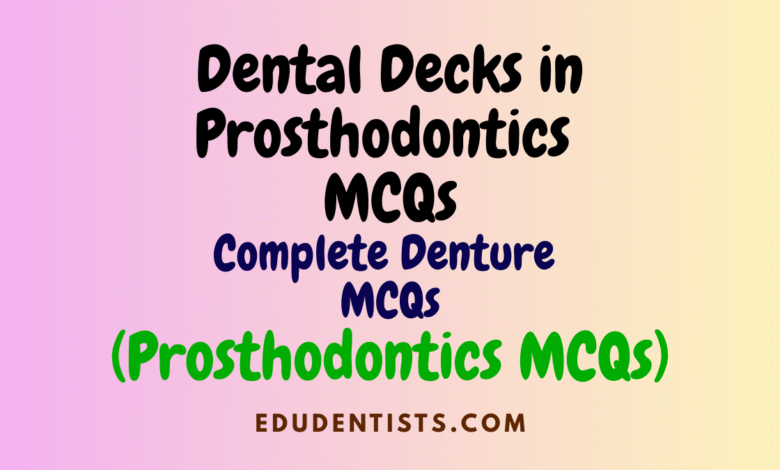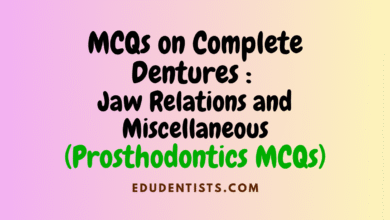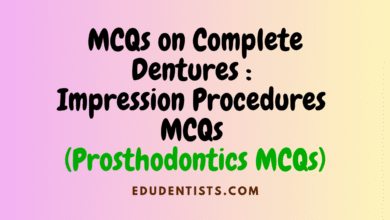Dental Decks in Prosthodontics MCQs _Complete Denture MCQs
Dental Decks in Prosthodontics MCQs _Complete Denture MCQs

Dental Decks in Prosthodontics MCQs _Complete Denture MCQs
1. The shape and amount of the distobuccal extension of a complete mandibular edentulous impression is determined during border molding by the:
A. Ramus of the mandible
B. Position and action of the masseter muscle
C. Lateral pterygoid muscle
D. Tone of the buccinator muscle
E. Size and location of the buccal frena
2. The distolingual extension of a complete mandibular edentulous impression is limited during border molding by the:
A. Superior constrictor muscle
B. Lateral pterygoid muscle
C. Medial pterygoid muscle
D. Ramus of the mandible
3. The primary reasons for obtaining the most extensive area coverage for a mandibular complete denture are:
A. To increase the capacity of underlying structures to withstand the stress due to biting force and to improve appearance
B. To provide balanced occlusion and to increase tongue space
C. To increase the capacity of the underlying structures to withstand the stress due to biting force and to increase the effectiveness of the seal
D. To improve retention and to increase tongue space
4. Immediate dentures should be rescheduled for relines:
A. 1 month and 3 months post extraction
B. 4 months and 7 months post extraction
C. 5 months and 10 months post extraction
D. 1 year and 2 years post extraction
5. All new dentures should be evaluated:
A. 3 hours after delivery
B. 12 hours after delivery
C. 24 hours after delivery
D. 48 hours after delivery
6. Posterior teeth that are set edge to edge may cause:
A. Gagging
B. Cheek biting
C. Reduced taste
D. Speech aberrations
7. A large anterior horizontal overlap may cause:
A. Lip biting
B. Cheek biting
C. Tongue biting
D. Gagging
8. A posterior teeth too far lingually may cause:
A. Lip biting
B. Cheek biting
C. Tongue biting
D. Gagging
9. Maxillary anterior teeth in a complete denture are usually arranged:
A. Facial to the ridge
B. Lingual to the ridge
C. Exactly over the ridge
10. Which sounds specifically may be affected by the incorrect placement ” too far superiorly and anteriorly” of maxillary anterior teeth in complete dentures?
A. “F” and “V” sounds
B. “S” and “Z” sounds
C. “P” and “B” sounds
D. “M” and “N” sounds
11. What is the recommended distance between the labial surface of the central incisor and the center of the incisive papilla?
A. Approximately 8 mm
B. Approximately 5 mm
C. Approximately 10 mm
D. Approximately 15 mm
12. A patient who wears a complete maxillary denture complains of a burning sensation in the palatal area of his/her mouth. This is Indicative of too much pressure being exerted by the denture on the:
A. Facial to the ridge
B. Lingual to the ridge
C. Exactly over the ridge
D. Incisive foramen
E. Palatal mucosa
F. Posterior palatal seal
13. A burning sensation in the mandibular anterior area is caused by pressure on the:
A. Mental foramen.
B. Lingual to the ridge
C. Facial to the ridge
D. Exactly over the ridge
14. How long should one expect to spend on establishing new memory patterns for facial and masticatory muscles with new dentures?
A. 2-4 weeks
B. 4-6 weeks
C. 6-8 weeks
D. 8-10 weeks
15. How long does it typically take to learn to chew satisfactorily with new dentures?
A. 2-4 weeks
B. 4-6 weeks
C. 6-8 weeks
D. 8-10 weeks
16. The treatment plan for a patient indicates that both manilibular and maxillary immediate dentures are to be fabricated. The ideal way to do this is:
A. Fabricate the maxillary immediate denture first
B. Fabricate the mandibular immediate denture first
C. Fabricate the maxillary and mandibular immediate dentures at the same time
17. The First step in the treatment of abused tissues in a patient with existing dentures is to:
A. Fabricate a new set of dentures
B. Reline the dentures
C. Educate the patient
D. Excise the abused tissues
18. The most important benefit of an overdenture (root retained denture) is:
A. The psychological comfort of avoiding the loss of all teeth
B. The continuous functional feedback for the neuromuscular system from proprioceptors in the periodontal membrane
C. The preservation of the alveolar ridge
D. The improved support and stability for the denture The increased retention of the denture
19. The incisal edges of the maxillary anterior teeth should just touch the wet/dry line of the lower lip when enunciating which sounds :
A. Linguo-alveolar sounds or sibilants (such as S, Z, Sh, Ch, J)
B. Fricatives or labiodental sounds (such as F, V, or Ph)
C. B, P, and M sounds
D. Linguodental sounds (such as this, that, or those)
20. Sounds that made with the tip of the tongue and the most anterior part of the palate or lingual surface of the maxillary teeth:
A. Linguo-alveolar sounds or sibilants (such as S, Z, Sh, Ch, J)
B. Fricatives or labiodental sounds (such as F, V, or Ph)
C. B, P, and M sounds
D. Linguodental sounds (such as this, that, or those)
21. Sounds that made by contact of the lips:
A. Linguo-alveolar sounds or sibilants (such as S, Z, Sh, Ch, J)
B. Fricatives or labiodental sounds (such as F, V, or Ph)
C. B, P, and M sounds
D. Linguodental sounds (such as this, that, or those)
22. Sounds that made when tip of the tongue protrude slightly between maxillary and mandibualr anterior teeth:
A. Linguo-alveolar sounds or sibilants (such as S, Z, Sh, Ch, J)
B. Fricatives or labiodental sounds (such as F, V, or Ph)
C. B, P, and M sounds
D. Linguodental sounds (such as this, that, or those)
23. What are the two most probable causes of a patient experiencing a “th” sound instead of an “s” sound?
A. Incisor teeth set too far palatally and a thick palate.
B. Incisor teeth set too far buccally and a thin palate.
C. Canine teeth set too far posteriorly and a thin palate.
D. Canine teeth set too far anteriorly and a thick palate.
24. Which dental factor could contribute to a patient’s “s” sound resembling a “th” sound?
A. Excessive overjet
B. Overlapping incisor edges
C. Lingually inclined canines
D. Palatally positioned incisor teeth
25. The primary role of anterior teeth on a denture is:
A. To incise food
B. Occlusion
C. Esthetics
D. Stability of the denture
26. What could be a potential cause of whistling when a patient speaks with dentures that replace the incisors?
A. Insufficient vertical overlap
B. Excessive horizontal overlap
C. Improper contouring of the area palatal to the incisors
D. All of the above
27. A patient has worn a complete maxillary denture for 8 years against mandibular anterior teeth. (the remainder of the mandibular teeth are missing) . She complains of looseness of the denture. Examination of the mouth shows an excessive amount of hyperplasatic tissue at the anterior part of the maxillary ridge. The maxillary denture teeth do not show below the upper lip. Radiographs show poor bone structure in the anterior part of the maxillae. The principle cause of difficulty with the maxillary denture is:
A. Fibrous tuberosities
B. Too great a vertical dimension of occlusion
C. A lack of posterior occlusion
D. The maxillary denture teeth that were used are too short
28. What factors influence denture surface?
A. Adhesion, cohesion, atmospheric pressure, mechanical factors
B. Saliva thickness, ridge size, peripheral seal, inter-ridge distance
C. Area covered, type of saliva, ridge shape, mechanical factors
D. Adhesion, atmospheric pressure, saliva type, ridge shape
29. Which factor is dependent on the type of saliva for denture surface?
A. Adhesion
B. Cohesion
C. Atmospheric pressure
D. Mechanical factors
30. What type of saliva is considered favorable for denture retention?
A. Thick and ropy
B. Thin and watery
C. Saliva viscosity does not affect denture retention
D. Saliva viscosity varies from person to person
31. Which mechanical factors influence denture surface?
A. Ridge size, shape, and inter-ridge distance
B. Saliva adhesion and cohesion
C. Atmospheric pressure and peripheral seal
D. Saliva type and area covered
32. What is the definition of denture retention?
A. The ability of the denture to withstand vertical dislodging forces
B. The ability of the denture to withstand horizontal dislodging forces
C. The ability of the denture to withstand chewing forces
D. The ability of the denture to withstand biting forces
33. Which of the following is NOT a surface that plays a part in denture retention?
A. Intimate contact of the denture base and its basal seat
B. Occlusal surfaces of the teeth
C. Labial polished surface
D. Lingual polished surface
34. Which factor should be avoided to maintain denture retention?
A. Intimate contact of the denture base and its basal seat
B. Occlusal prematurities
C. Labial, buccal, and lingual polished surfaces
D. Forces exerted in the vertical plane
35. The primary indicator of the accuracy of border molding is:
A. Adequate coverage of tray borders with the material used for border molding
B. Contours o the periphery similar to the final form of the denture
C. Stability and lack o displacement of the tray in the mouth
D. Uniformly thick borders of the periphery
36. You’re in the process of making complete maxillary denture for a patient. hich of the following will be a secondary support area:
A. Residual ridges
B. Palatal rugae
C. Incisive papilla
D. Maxillary tuberosity
E. Buccal vestibule
37. An overextended distobuccal corner of a mandibular denture will push against which muscle during function?
A. Zygomaticus
B. Orbicularis oris
C. Temporalis
D. Masseter
38. After border molding the mandibuhr custom tray, it is important to check for dislodgement in order to detect areas of:
A. Underextension of the tray
B. Overextension of the tray
C. Thickness of the tray
D. None of the above
39. Before an accurate facebow transfer record can be made on patient, which of the following must be determined:
A. The inclination of each condyle
B. Vertical dimension of occlusion
C. Centric relation
D. Location of the hinge axis point – axial center of opening-closing
40. A plaster index is used to:
A. Maintain the vertical dimension of occlusion
B. Maintain bite registration
C. Preserve the face-bow transfer
D. All of the above
41. A generalized speech difficulty with dentures is usually cused by which two of the following
A. Faulty tooth position and palatal contours
B. Faulty occlusion
C. Excess vertical dimension of occlusion
42. What is the cause of the “whistle” sound during “S” sounds in denture wearers?
A. Excessive impedance between the tongue and anterior palate
B. Inadequate impedance between the tongue and anterior palate
C. Excessive rugae on the palate
D. Insufficient palatal resin convex contours
43. How can the “whistle” sound during “S” sounds be treated?
A. Thin the palatolingual area
B. Increase the palatal resin convex contours lingual to the maxillary central incisors
C. Create rugae on the palate
D. Reduce the occlusal vertical dimension
44. What is the cause of contact between maxillary and mandibular incisors or premolars during sibilant sounds (s, sh, z, ch)?
A. Excessive impedance between the tongue and anterior palate
B. Inadequate impedance between the tongue and anterior palate
C. Excessive occlusal vertical dimension
D. Excessive labial positioning of maxillary teeth
45. How can contact between maxillary and mandibular incisors or premolars during sibilant sounds (s, sh, z, ch) be treated?
A. Increase the palatal resin convex contours lingual to the maxillary central incisors
B. Reduce the occlusal vertical dimension until premolars no longer contact during speech
C. Evaluate lip support and overall appearance of anterior teeth
D. Thin the palatolingual area
46. How can the lisp on “S” sounds be treated in dentures?
A. Thin the palatolingual area
B. Increase the palatal resin convex contours lingual to the maxillary central incisors
C. Reduce occlusal vertical dimension until premolars no longer contact during speech
D. Evaluate lip support and reset anterior teeth to a more lingual position
47. What is the cause of the incisal edges of maxillary incisors contacting the lower lip during “F” and “V” sounds in dentures?
A. Excessive impeding of the air stream between the tongue and anterior palate
B. Insufficient impedance between the dorsal surface of the tongue and the anterior palate
C. Occlusal vertical dimension is too great
D. Maxillary teeth are set too far labially
48. How can the problem of incisal edges contacting the lower lip during “F” and “V” sounds be treated in dentures?
A. Thin the palatolingual area
B. Increase the palatal resin convex contours lingual to the maxillary central incisors
C. Reduce occlusal vertical dimension until premolars no longer contact during speech
D. Evaluate lip support and reset anterior teeth to a more lingual position
49. At the first appointment after insertion of complete dentures the presence of generalized soreness on the crest of the mandibular ridge is most likely due to:
A. The newness of the denture
B. Defective tissue registration
C. Premature occlusal contacts
D. lncornplete polymerization of the denture base
50. The inferior surface of the maxillary occlusion rim should be parallel to:
A. Frankfort’s plane
B. Camper’s line
C. Fox plane
D. Horizontal condylar inclination
51. What is the purpose of establishing the vertical dimension of occlusion using occlusion rims?
A. To create a stable base for denture fabrication
B. To ensure proper alignment of the upper and lower teeth
C. To establish the correct height and position of the artificial teeth
D. All of the Above
52. Occlusion rims are used to:
A. Determine and establish the vertical dimension of occlusion
B. Make maxillo-mandibular jaw records
C. Establish and locate the future position of the artificial teeth
D. All of the above.
53. The most frequent cause of porosities in a denture is:
A. Insufficient pressure on the flask during processing
B. Insufficient material in the mold
C. A rapid elevation in temperature to 212 F causing vaporization of the liquid
D. Insufficient time for processing
54. All of the following are disadvantages to immediate denture therapy but which one is the MAJOR disadvantage:
A. Increased post-insertion care
B. Increased post-insertion soreness
C. Not being able to have an anterior tooth try-in to evaluate esthetics
D. Greater complexity of clinical procedures
E. A higher cost oftreatment
55. The posterior palatal seal for a maxillary denture:
A. Is placed 3 mm posterior to the vibrating line
B. Is not necessary when fabricating a complete denture on a patient with a flat palate
C. Is not necessary if a metal base is used
D. Will vary in outline and depth according to the palatal form ofthe patient
56. All of the following are true concerning a facebow or a facebow transfer EXCEPT:
A. The face-bow is a caliper-like device used to record the patient’s maxilla,/hinge axis relationship (opening and closing axis).
B. If the transfer is done properly, the arc of closure on the articulator should duplicate that exhibited by the patient.
C. The face-bow transfer is a maxillo-mandibular record.
D. The face-bow transfer is used to transfer the maxilla/hinge axis relationship to the articulator during the mounting of the maxillary cast.
57. Which of the following landmarks is least relevant to the location of the posterior palatal seal area:
A. Pterygomaxillary notch
B. Vibrating line
C. Hamular process
D. Fovea palatinae
58. What is the function of the posterior palatal seal in a maxillary denture?
A. Completes the border seal of the maxillary denture
B. Prevents impaction of food beneath the tissue surface of the denture
C. Improves the physiologic retention of the denture
D. Compensates for shrinkage of the denture resin during processing
E. All of the above
59. All of the following are morphological changes associated with the edentulous state EXCEPT:
A. Deepening of nasolabial groove
B. Loss of labiodental angle
C. Retrognathic appearance
D. Decrease in horizontal labial angle
E. Narrowing of lips
F. Increase in columella-philtral angle





